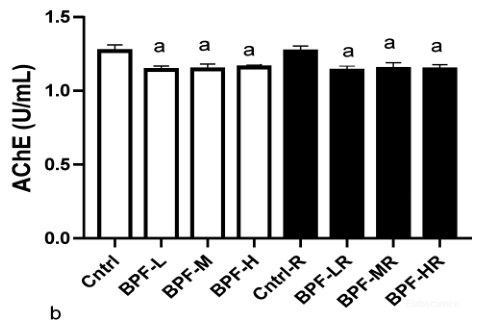Acetylcholinesterase (AchE) Activity Assay Kit
To better serve you, we would like to discuss your specific requirement, Please Contact Us for a quote.
Acetylcholinesterase (AchE) Activity Assay Kit
| SKU # | E-BC-K174-M |
| Detection Instrument | Microplate reader (optimum wavelength: 412 nm) |
| Detection method | Colorimetric method |
Product Details
Properties
| Synonyms |
AchE |
| Sample Type | Serum, plasma, animal tissue and cell |
| Sensitivity | 1.225 U/mL |
| Detection Range | 1.225-490 U/mL |
| Detection Method | Colorimetric method |
| Assay type | Enzyme Activity |
| Assay time | 20 min |
| Precision | Average inter-assay CV: 9.300% | Average intra-assay CV: 4.700% |
| Other instruments required | Micropipettor, Incubator, Vortex mixer, Centrifuge |
| Other reagents required | Normal saline (0.9% NaCl), PBS (0.01 M, pH 7.4) |
| Storage | 2-8℃ |
| Valid period | 12 months |
Images
A F Odetayo et al investigate the effect of bisphenol F on sexual performance and quality. Acetylcholinesterase (AchE) activity of rat plasma was determined using AchE activity assay kit (E-BC-K174-M).

The activity of AchE was significantly decreased comparing with control groups. (P<0.05 versus age-matched control)
Dilution of Sample
It is recommended to take 2~3 samples with expected large difference to do pre-experiment before formal experiment and dilute the sample according to the result of the pre-experiment and the detection range (13.88-320.13 U/mL).
The recommended dilution factor for different samples is as follows (for reference only):
| Sample type | Dilution factor |
| Mouse serum | 8-20 |
| Mouse plasma | 4-10 |
| Human serum | 4-10 |
| Human plasma | 4-10 |
| Rat serum | 4-10 |
| Dog serum | 4-10 |
| Horse serum | 2-8 |
| 10% Mouse liver tissue homogenate | 1 |
| 10% Mouse kidney tissue homogenate | 1 |
| 10% Mouse brain tissue homogenate | 2-8 |
| 10% Crucian carp muscle tissue homogenate | 1 |
Note: The diluent is normal saline (0.9% NaCl) or PBS (0.01 M, pH 7.4).
Detection Principle
AchE catalyzes the hydrolysis of acetylcholine to form choline, and choline react with dithio p-nitrobenzoic acid (DTNB) to form 5-mercapto-nitrobenzoic acid (TNB). TNB has an absorption peak at 412nm. And the activity of AchE is calculated by measuring the increasing rate of absorbance at 412nm.
Kit Components & Storage
| Item | Component | Size 1(48 T) | Size 2(96 T) | Storage |
| Reagent 1 | Lysis Buffer | 50 mL × 1 vial | 50 mL × 2 vials | 2-8°C, 12 months |
| Reagent 2 | Buffer Solution | 15 mL × 1 vial | 30 mL × 1 vial | 2-8°C, 12 months |
| Reagent 3 | Chromogenic Agent | Powder × 1 vial | Powder × 1 vial | 2-8°C, 12 months, shading light |
| Reagent 4 | Substrate | Powder × 1 vial | Powder × 1 vial | 2-8°C, 12 months, shading light |
| Microplate | 96 wells | No requirement | ||
| Plate Sealer | 2 pieces | |||
Note: The reagents must be stored strictly according to the preservation conditions in the above table. The reagents in different kits cannot be mixed with each other. For a small volume of reagents, please centrifuge before use, so as not to obtain sufficient amount of reagents.
Technical Data:
Parameter:
Intra-assay Precision
Three human serum samples were assayed in replicates of 20 to determine precision within an assay. (CV = Coefficient of Variation)
| Parameters | Sample 1 | Sample 2 | Sample 3 |
| Mean (U/mL) | 10.20 | 88.50 | 264.00 |
| %CV | 5.2 | 4.6 | 4.3 |
Inter-assay Precision
Three human serum samples were assayed 20 times in duplicate by three operators to determine precision between assays.
| Parameters | Sample 1 | Sample 2 | Sample 3 |
| Mean (μg/mL) | 10.20 | 88.50 | 264.00 |
| %CV | 9.1 | 9.3 | 9.5 |
Recovery
Take three samples of high concentration, middle concentration and low concentration to test the samples of each concentration for 6 times parallelly to get the average recovery rate of 104%.
| Standard 1 | Standard 2 | Standard 3 | |
| Expected Conc. (U/mL) | 138.5 | 252 | 381.3 |
| Observed Conc. (U/mL) | 146.8 | 257.0 | 396.6 |
| Recovery rate (%) | 106 | 102 | 104 |
Sensitivity
The analytical sensitivity of the assay is 1.225 U/mL. This was determined by adding two standard deviations to the mean O.D. obtained when the zero standard was assayed 20 times, and calculating the corresponding concentration.



